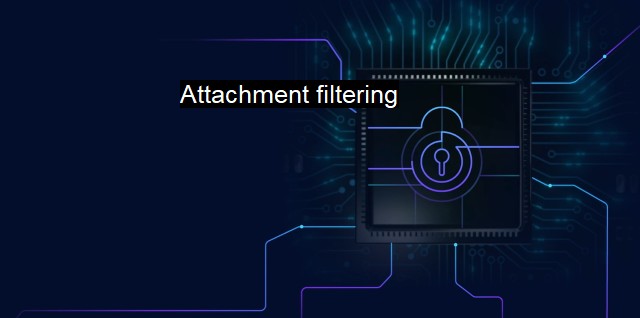What is Attachment filtering?
Unpacking the Importance of Attachment Filtering in Email Security: Strategies and Technologies to Safeguard Against Malware and Harmful Content
"Attachment filtering" in the context of cybersecurity refers to the method of examining and handling incoming files, often via email, based on predefined criteria. This can range from automatically deleting emails that come with certain types of attachments, to quarantining suspicious files for later analysis.Attachments constitute one of the primary methods used to infiltrate computers and networks in any security landscape. Malicious entities including viruses, worms, and all sorts of malware often take advantage of an unfiltered or poorly filtered system by attaching dangerous payloads to seemingly innocuous files. These are then delivered mostly through emails or downloaded from a web resource.
The mechanism of attachment filtering works to counter this strategy by applying a set of rules to identify potential threats. For instance, an attachment filter can be set up to block or quarantine any incoming files that are unidentified, or that have double extensions (e.g., .jpg.exe). In this example, due to the filter's settings, any files fitting these descriptions will be immediately acted upon.
The way attachment filtering is applied can vary significantly from one antivirus software to another. Many first-level filters are configured to immediately delete emails or files that come with attachments with well-known hazardous extensions like .exe, .bat, .com, among others. such defaults are often not foolproof and demand specific refinement to maximize efficacy.
Advanced filtering systems apply a more comprehensive approach than merely filtering based on file extensions. These systems are capable of scanning the content of the files themselves for potential threats. For instance, they may search for known signatures of malware inside the code of executable files. Other filters could use machine learning techniques to understand the behavior of a file when executed in a sandboxed environment, providing insights into whether it's potentially malicious or not.
Attachment filtering is not limited only to malicious codes aiming to infiltrate a system. It also applies to unnecessary content found in advertisements, spam emails and other undesired communication. By stripping out superfluous content, filtering mechanisms can contribute to better network performance, increasing business productivity, and providing an additional layer of information security.
Beyond simply detecting and filtering attachments, a comprehensive strategy includes generating alerts and providing reports globally or on a per-user basis. An excellent filtering solution communicates efficiently with system administrators regarding potential threats, providing sufficient information for a quick and confident response.
It is key to strike a delicate balance when configuring filters; overzealous filtering can unintentionally block harmless yet important files, while too loose a configuration may allow malicious software to slip through. Properly structured, an intelligent filtering feature should adapt according to the software or organization's experiences, better preparing it against ongoing and future threats.
It's also noteworthy that the majority of attachment filtering takes place in real-time as files are received, but there are also scheduled scans that take place periodically.
In a cyber-environment characterized by rapidly evolving threats and proliferated attack vectors, attachment filtering represents a crucial line of defense. While offering a critical level of protection, it should ideally be an addition to a multidimensional, profound approach to cybersecurity including secure practices and strategies like threat intelligence, vulnerability scanning, encryption, user awareness training, and more.
Adequate attachment filtering backed by reliable anti-virus software is indispensable in today's digitally-connected world. By filtering out potentially harmful or irrelevant content, organizations and individuals can save valuable resources, protect their data, and enhance their operational performance. understanding and regularly enhancing the effectiveness of this feature is a foundational strategy for securing a business's digital presence.

Attachment filtering FAQs
What is attachment filtering in cybersecurity?
Attachment filtering is a technique used by antivirus programs to scan and filter email attachments for potential threats. It helps protect users from malware and other harmful viruses that can be transmitted via email attachments.How does attachment filtering work?
Attachment filtering works by examining the contents of an email attachment and comparing it to a list of known threats. If the attachment matches a known threat, it is either blocked or quarantined to prevent it from being opened.What types of threats can attachment filtering detect?
Attachment filtering can detect a range of potential threats, including malware such as viruses, worms, and Trojan horses, as well as phishing attacks, malicious scripts, and other harmful files.Why is attachment filtering important for cybersecurity?
Attachment filtering is important for cybersecurity because email attachments are a common way for attackers to distribute malware and other malicious programs. By filtering attachments, antivirus programs can help prevent these threats from infecting a user's system or network. This helps to ensure the overall security of the organization and protects against data loss, theft, and other cyber attacks.| | A | | | B | | | C | | | D | | | E | | | F | | | G | | | H | | | I | | | J | | | K | | | L | | | M | |
| | N | | | O | | | P | | | Q | | | R | | | S | | | T | | | U | | | V | | | W | | | X | | | Y | | | Z | |
| | 1 | | | 2 | | | 3 | | | 4 | | | 7 | | | 8 | | |||||||